Il Nepal torna a scuola dopo il sisma
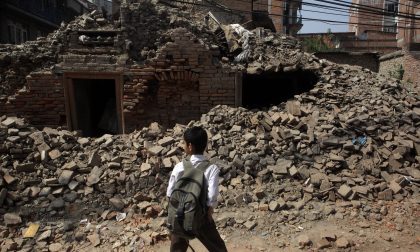
Tornano a scuola 14mila bambini del Nepal, ad inseguire una parvenza di vita normale dopo il violentissimo sisma che ha colpito il Paese il 25 aprile scorso. In molti casi si tratta di scuole provvisorie, allestite in edifici di fortuna fatti di lamiere, bambù e teli di plastica. E in contemporanea più di 100 squadre di tecnici ingegneri sono al lavoro nei 16 distretti colpiti per raccogliere dati sui danni e stilare un elenco dei luoghi sicuri dove poter riprendere le lezioni, perché è importante che i bambini tornino sui banchi di scuole senza rischi.
Il trauma del rientro. È stato un rientro difficile, segnato dal dolore per i tanti morti provocati dal sisma. Molti bambini oltre a non avere più la loro scuola non hanno nemmeno più i loro compagni. Serve quindi un programma di aiuto per superare il trauma. Per questo nei primi giorni le lezioni riprenderanno gradualmente e saranno incentrate su attività di gruppo. L’Unicef e i suoi partner hanno fornito materiali didattici, kit ricreativi e per la prima infanzia ai bambini di quei distretti dove i danni del sisma sono stati più ingenti. Inoltre è stato predisposto un piano di supporto attraverso la formazione di 1142 insegnanti per il sostegno psicologico ai bambini. I bambini sono infatti le vittime più vulnerabili del sisma e secondo l’Unicef il ritorno a scuola potrebbe aiutarli a farli tornare a una situazione di normalità, o quantomeno può essere un modo per cercare di limitare i danni psicologici di quanto stanno vivendo. Molti di loro hanno smesso di parlare e hanno paura di essere lasciati dai genitori quando questi riprenderanno ad andare a lavorare.
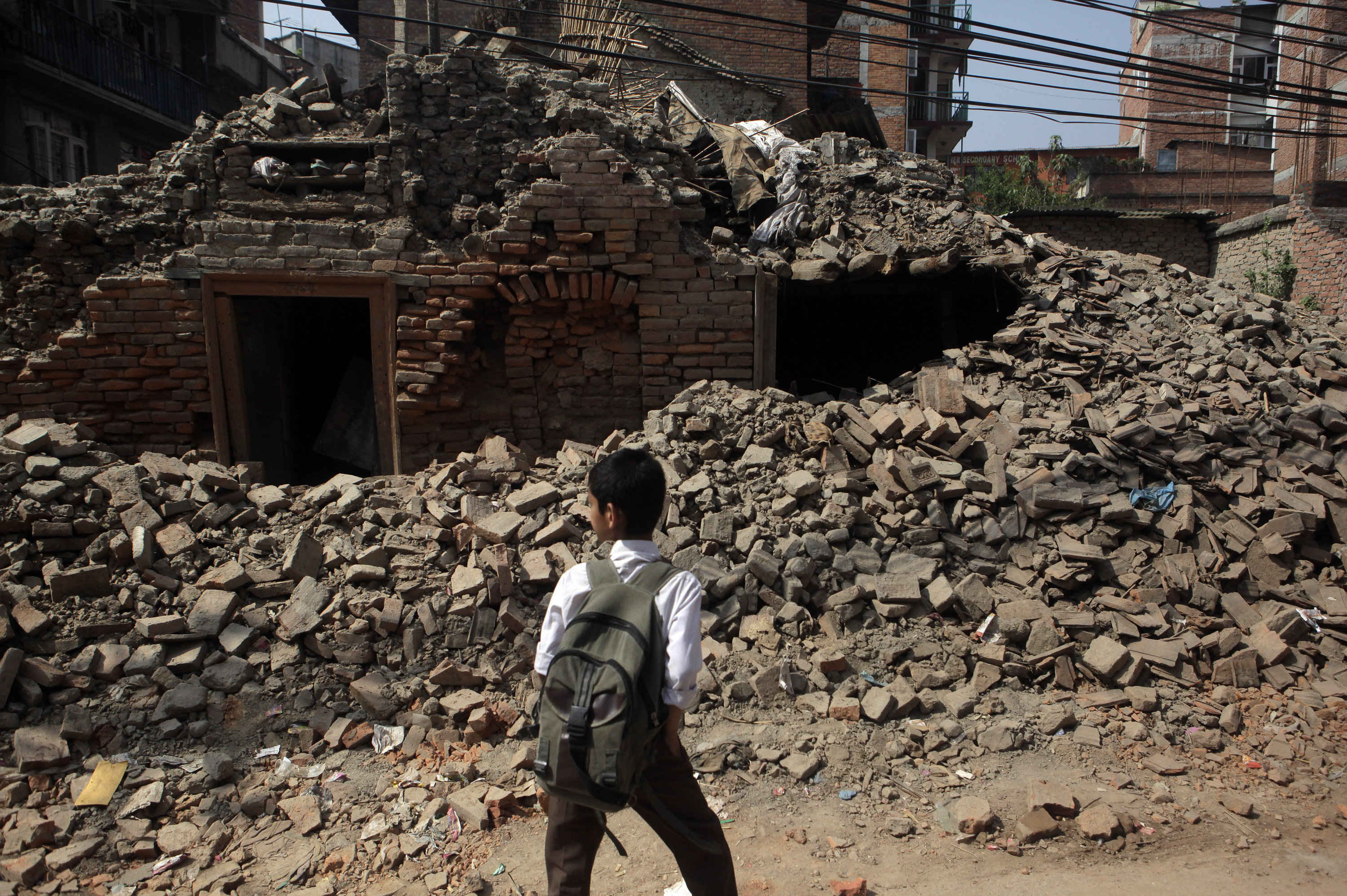
A Nepalese boy walks past a collapsed building close to his school, as thousands of schools across the districts worst hit by two major earthquakes in Nepal reopened Sunday, in Kathmandu, Nepal, Sunday, May 31, 2015. With most school buildings damaged or unsafe, the Education Ministry ordered that classes be held in temporary classrooms. According to a UNICEF statement, 32,000 classrooms were destroyed and 15,352 classrooms were damaged after the two major earthquakes in Nepal. (AP Photo/Niranjan Shrestha)
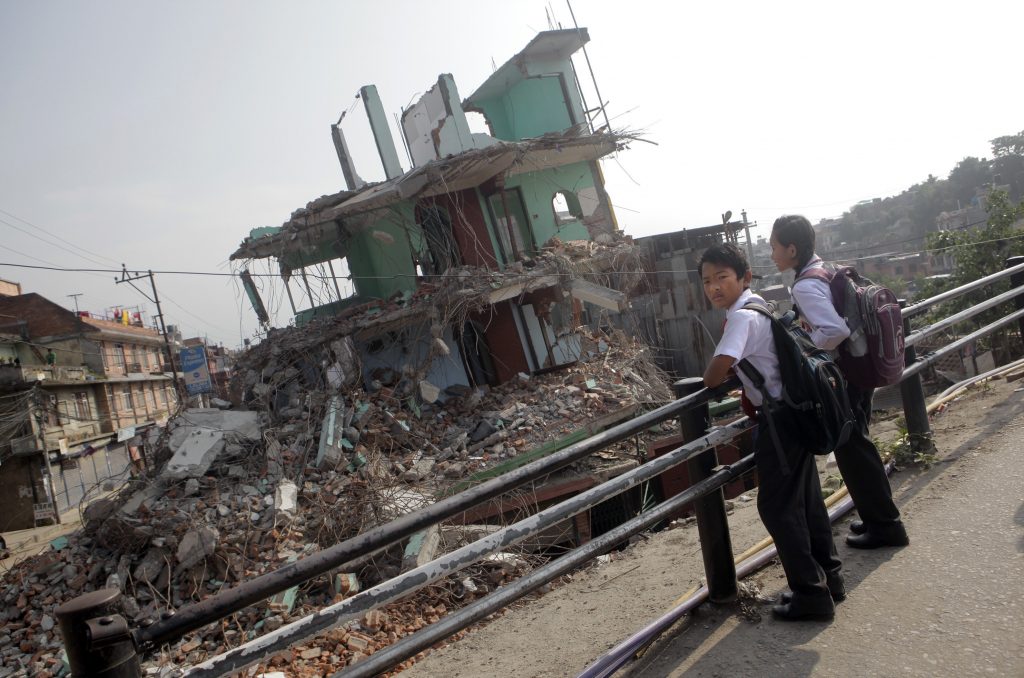
Nepalese students wait for their school bus in front of a collapsed house as thousands of schools across the districts worst hit by two major earthquakes in Nepal reopened Sunday, in Kathmandu, Nepal, Sunday, May 31, 2015. With most school buildings damaged or unsafe, the Education Ministry ordered that classes be held in temporary classrooms. According to a UNICEF statement, 32,000 classrooms were destroyed and 15,352 classrooms were damaged after the two major earthquakes in Nepal. (AP Photo/Niranjan Shrestha)
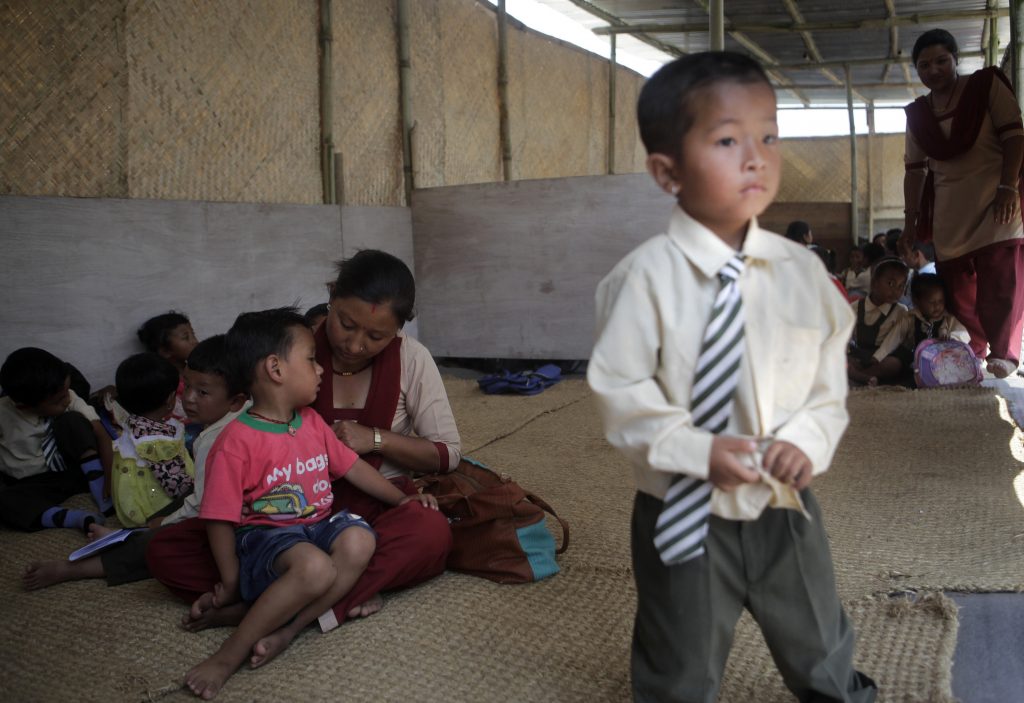
Nepalese children sit inside a makeshift school, as thousands of schools across the districts worst hit by two major earthquakes in Nepal reopened Sunday, in Kathmandu, Nepal, Sunday, May 31, 2015. With most school buildings damaged or unsafe, the Education Ministry ordered that classes be held in temporary classrooms. According to a UNICEF statement, 32,000 classrooms were destroyed and 15,352 classrooms were damaged after the two major earthquakes in Nepal. (AP Photo/Niranjan Shrestha)
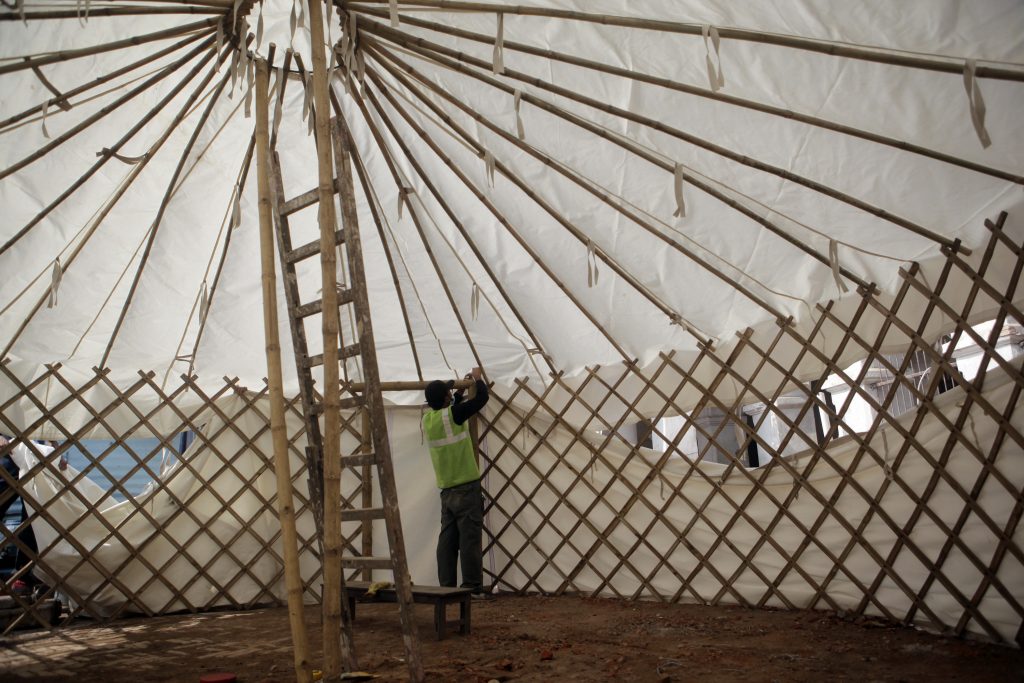
A Nepalese man constructs a tent which will serve as a temporary school, as thousands of schools across the districts worst hit by two major earthquakes in Nepal reopened Sunday, in Kathmandu, Nepal, Sunday, May 31, 2015. With most school buildings damaged or unsafe, the Education Ministry ordered that classes be held in temporary classrooms. According to a UNICEF statement, 32,000 classrooms were destroyed and 15,352 classrooms were damaged after the two major earthquakes in Nepal. (AP Photo/Niranjan Shrestha)
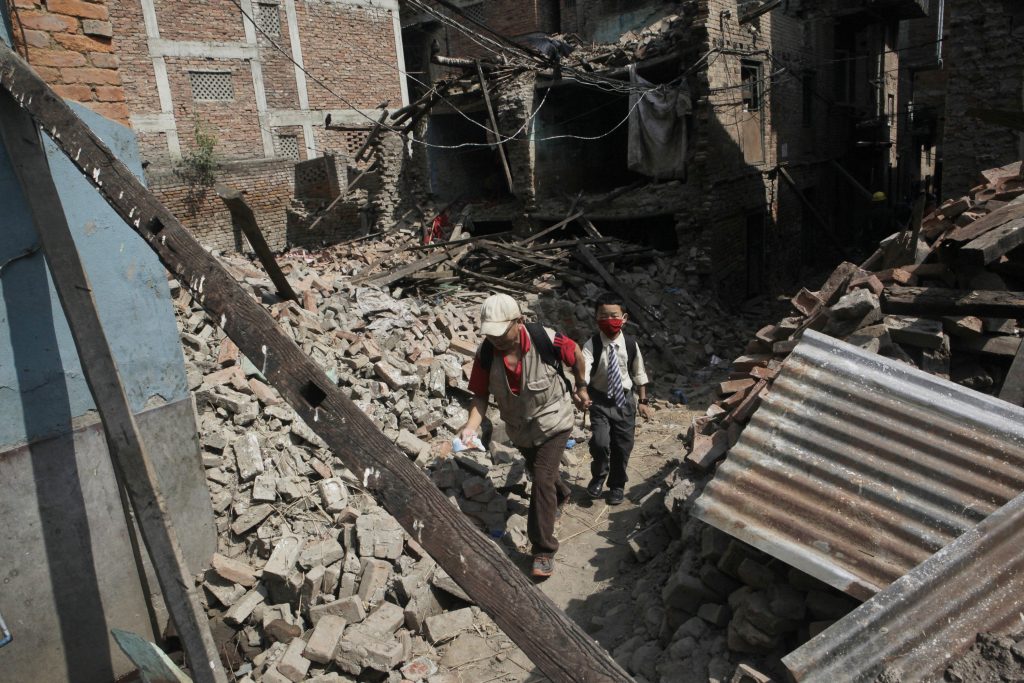
A Nepalese man leads his son past debris towards his school, as thousands of schools across the districts worst hit by two major earthquakes in Nepal reopened Sunday, in Kathmandu, Nepal, Sunday, May 31, 2015. With most school buildings damaged or unsafe, the Education Ministry ordered that classes be held in temporary classrooms. According to a UNICEF statement, 32,000 classrooms were destroyed and 15,352 classrooms were damaged after the two major earthquakes in Nepal. (AP Photo/Niranjan Shrestha)
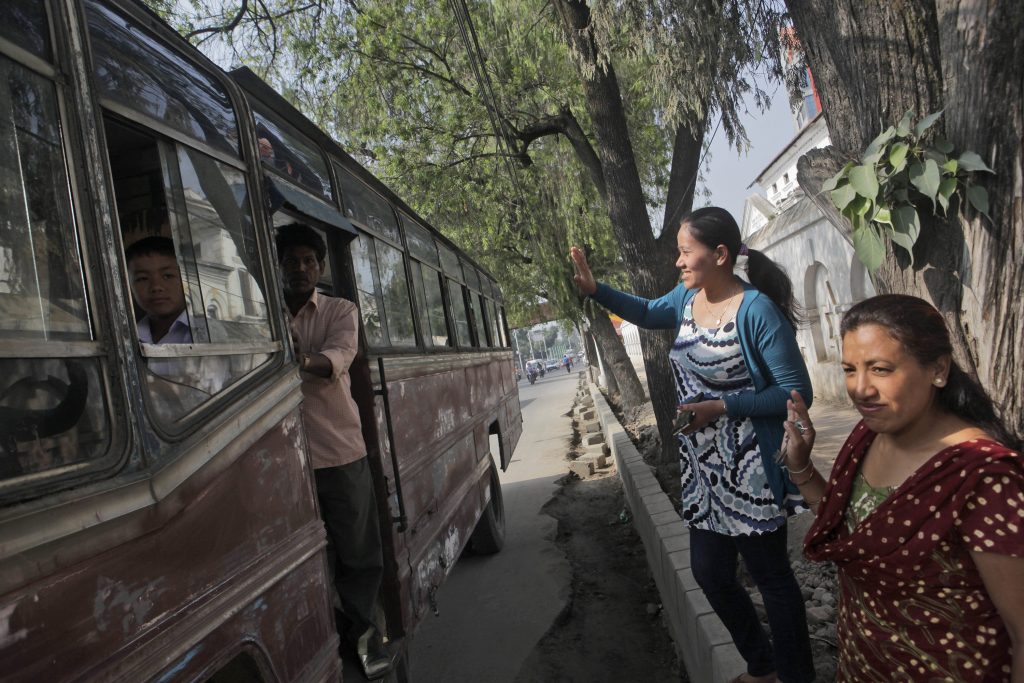
Nepalese women wave at children traveling to school in a school bus, as thousands of schools across the districts worst hit by two major earthquakes in Nepal reopened Sunday, in Kathmandu, Nepal, Sunday, May 31, 2015. With most school buildings damaged or unsafe, the Education Ministry ordered that classes be held in temporary classrooms. According to a UNICEF statement, 32,000 classrooms were destroyed and 15,352 classrooms were damaged after the two major earthquakes in Nepal. (AP Photo/Niranjan Shrestha)
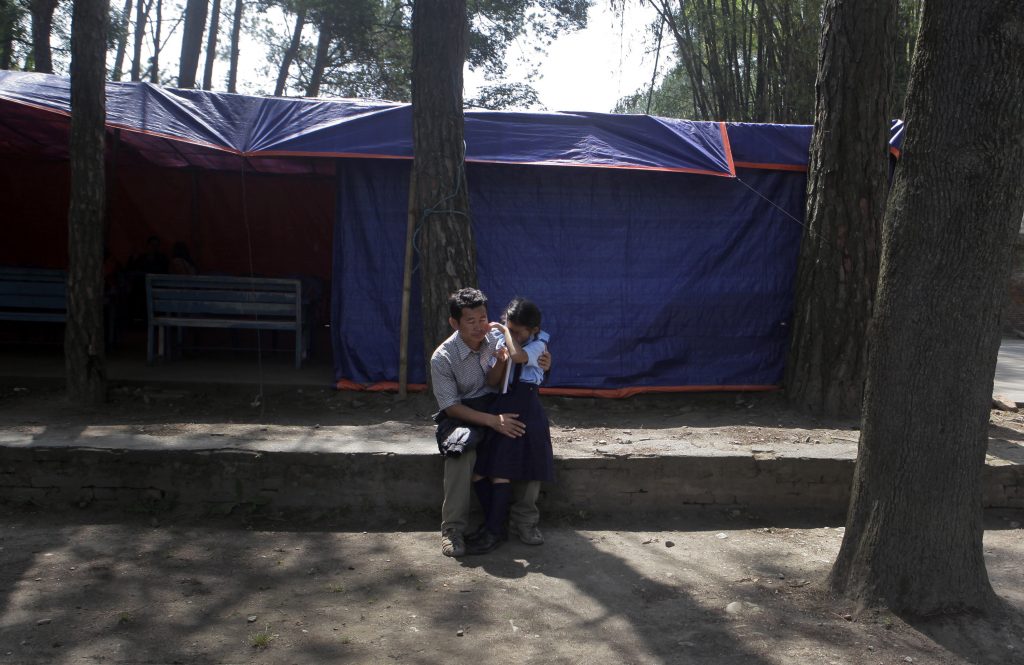
A Nepalese man comforts his crying daughter at her school premise, as thousands of schools across the districts worst hit by two major earthquakes in Nepal reopened Sunday, in Kathmandu, Nepal, Sunday, May 31, 2015. With most school buildings damaged or unsafe, the Education Ministry ordered that classes be held in temporary classrooms. According to a UNICEF statement, 32,000 classrooms were destroyed and 15,352 classrooms were damaged after the two major earthquakes in Nepal. (AP Photo/Niranjan Shrestha)
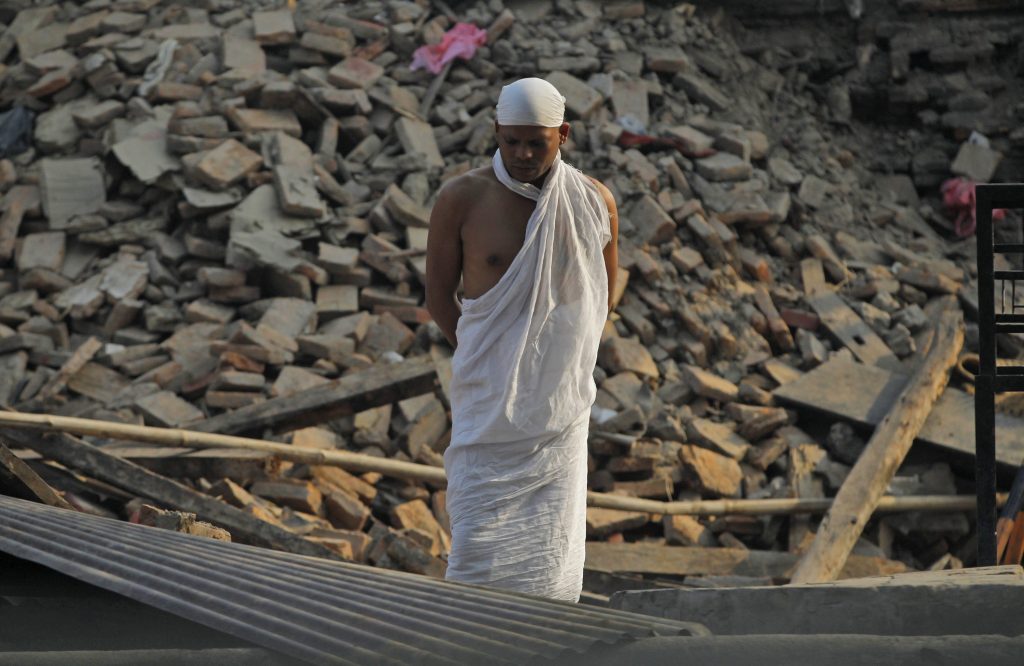
A Nepalese man, who lost family members to last week's earthquake, stands in front of a damaged house as he waits to perform rituals to end the mourning period in Kathmandu, Nepal, Thursday, May 7, 2015. The April 25 earthquake killed thousands and injured many more as it flattened mountain villages and destroyed buildings and archaeological sites in Kathmandu. (AP Photo/Niranjan Shrestha)
La campagna contro l’abbandono scolastico. È stata avviata anche una campagna di sensibilizzazione e di comunicazione per preparare i bambini a reagire di fronte a un disastro, sulla salute, sull'igiene e sulla protezione. Sono i media nepalesi a diffondere l’importanza dell’educazione dei più piccoli, affinché, nonostante i danni del terremoto siano stati enormi, le famiglie non decidano di far loro abbandonare la scuola: sono infatti 985mila i bambini che non sono potuti tornare a scuola. Quello dell’Unicef è un impegno che va di pari passo con quello del Ministero dell’Istruzione nepalese, che vuole riportare a scuola il maggior numero di bambini nel più breve tempo possibile. Perché uno dei rischi più gravi che corrono i bambini delle popolazioni più duramente colpite, è quello dell’abbandono scolastico. Soprattutto nelle province di Gorkha, Sindhupalchowk e Nuwakot, dove il 90 percento degli edifici è andato distrutto, e tra questi molte scuole. Si calcola che in tutto il Paese sono state oltre 8mila le scuole rase al suolo o danneggiate dal sisma che ha causato, stando agli ultimi dati forniti dal governo nepalese, più di 8600 morti e 16800 feriti, oltre a 3 milioni di sfollati.
Il rischio malnutrizione. E accanto al rischio dell’abbandono scolastico per i bambini nepalesi si è profilato all’orizzonte anche il rischio della malnutrizione. A lanciare l’allarme a un mese dal sisma sono stati Unicef e Save The Children: circa 70mila bambini sotto i 5 anni sono a rischio malnutrizione. Urge quindi un supporto nutrizionale per evitare un ulteriore disastro e prevenire un deterioramento della condizioni nutritive dei bambini. Secondo le stime dell'Unicef, in 15mila soffrono di denutrizione acuta grave. e avranno bisogno di alimenti terapeutici, mentre 55mila bambini con malnutrizione acuta moderata necessitano di alimenti supplementari e cure per poter ritornare ad uno status ottimale per la loro salute e lo sviluppo. Save the Children rincara la dose, mettendo in evidenza i rischi che corrono le circa 92mila donne incinte. Molte di loro, infatti, vivono ora all'aperto perchè le loro case sono state danneggiate o distrutte, con i loro bambini, sotto teli di plastica, al freddo e in condizioni sempre più insalubri. Tra poche settimane, le forti piogge rischiano di aumentare la diffusione delle malattie, in particolare di quelle trasmesse attraverso l'acqua, come il colera. La situazione è ancora più critica se ci si riferisce alle strutture sanitarie. Nelle zone maggiormente colpite dal terremoto il 73 percento delle strutture sanitarie che forniscono assistenza alla maternità sono state danneggiate o distrutte, lasciando alle donne scarse possibilità di accesso all'assistenza sanitaria neonatale e postnatale.